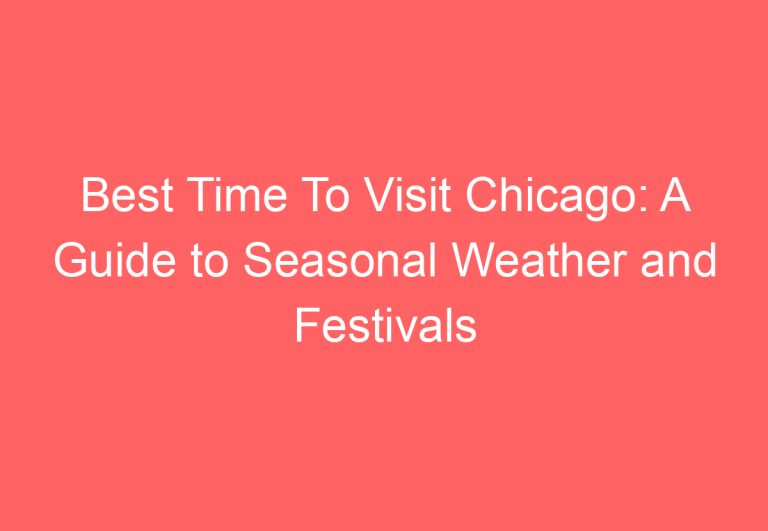Best Time To Visit Banff: A Guide To The Seasons
Banff National Park in Canada is a breathtaking destination that offers visitors a chance to experience the beauty of the great outdoors. With its pristine scenery, glacial lakes, and endless outdoor activities, Banff is a must-visit location for nature lovers. However, the best time to visit Banff can vary depending on your preferences and budget.

If you’re looking for warm weather and a bustling atmosphere, the best time to visit Banff is from June to August. During this time, the weather is warm and welcoming, making it perfect for hiking, camping, and wildlife watching. However, this is also the peak season, so be prepared for higher hotel rates and larger crowds.
If you’re looking for a winter wonderland and world-class skiing, the best time to visit Banff is from December to March. During this time, the park is transformed into a winter wonderland, with snow-covered mountains and frozen lakes. This is also the best time for skiing, snowboarding, and other winter sports. However, be prepared for colder temperatures and shorter days.
Seasonal Highlights and Activities

When planning a trip to Banff, it’s important to consider the season you’ll be visiting in, as each season offers unique highlights and activities. In this section, we’ll take a closer look at what you can expect during each season in Banff National Park.
Winter Wonderland: Skiing and Snow Activities
Winter is a magical time to visit Banff, with snow-covered mountains, frozen lakes, and a variety of winter sports to enjoy. Skiing and snowboarding are the most popular activities during this season, with three world-class ski resorts to choose from: Banff Mount Norquay, Sunshine Village, and Lake Louise Ski Resort. If skiing isn’t your thing, there are plenty of other snow activities to enjoy, such as snowshoeing, ice skating, ice climbing, and dog sledding.
Summer Adventures: Hiking and Lakes
Summer is peak season in Banff, and for good reason. With warm weather and sunny days, it’s the perfect time to explore the park’s many hiking trails and stunning lakes. Some of the most popular lakes to visit include Lake Louise, Moraine Lake, and Lake Minnewanka. Visitors can also enjoy a scenic drive along the Icefields Parkway or take a gondola ride for breathtaking views of the Rocky Mountains. Other popular activities include biking, kayaking, fishing, and canoeing.
Spring and Fall: Shoulder Seasons
Spring and fall are considered shoulder seasons in Banff, with fewer crowds and more unpredictable weather. However, these seasons offer their own unique highlights, such as wildflowers in the spring and fall foliage in the fall. Wildlife viewing is also popular during these seasons, with the chance to spot bighorn sheep, deer, elk, and even bears. Visitors can also enjoy scenic drives along the Bow Valley Parkway and attend events hosted by Parks Canada.
When planning your trip to Banff, it’s important to consider the season you’ll be visiting in and plan accordingly. Whether you’re looking for winter sports, summer adventures, or a quieter shoulder season experience, Banff National Park has something for everyone.
Planning Your Trip

When planning your trip to Banff, there are several factors to consider to ensure you have an enjoyable and stress-free experience. This section will provide you with some useful information on the best times to visit for weather and crowds, accommodation and reservations, activities and events, as well as transportation and accessibility.
Best Times to Visit for Weather and Crowds
The best time to visit Banff National Park depends on your preferences and what you want to experience. If you’re looking for warm weather and longer days, the months of June to August are ideal. However, this is also peak season, which means larger crowds and higher prices. Shoulder seasons, such as April to May and September to October, offer milder weather, fewer crowds, and better deals on accommodations.
Accommodation and Reservations
It’s important to book your accommodations in advance, especially during high season. Banff offers a variety of lodging options, including hotels, motels, lodges, and campgrounds. If you’re looking to stay in the town of Banff, make sure to book well in advance as the town can get quite busy during peak season. If you prefer a quieter and more secluded experience, consider staying in one of the nearby towns or villages.
Activities and Events
Banff National Park is a year-round destination, offering a variety of activities and events for visitors to enjoy. In the summer, visitors can hike, bike, fish, kayak, canoe, and go horseback riding. In the winter, skiing, snowboarding, snowshoeing, and ice skating are popular activities. Regardless of the season, visitors can also enjoy sightseeing, wildlife viewing, and visiting the many lakes and waterfalls in the park.
Transportation and Accessibility
Banff National Park is easily accessible by car, bus, or train. The park is located in the Canadian Rockies, about 80 miles west of Calgary, Alberta. The most scenic way to get to Banff is by taking the Trans-Canada Highway or the Icefields Parkway. Visitors can also take a shuttle bus or a guided tour from Calgary or other nearby cities. Once in the park, visitors can use the public transportation system, including the Roam Transit bus system, to get around.
Overall, Banff National Park is a must-visit destination for anyone looking for outdoor adventure, stunning scenery, and a chance to connect with nature. By planning your trip ahead of time and considering the factors mentioned above, you can ensure a memorable and enjoyable experience in this beautiful part of Canada.
Frequently Asked Questions

What are the peak tourist seasons in Banff National Park?
Banff National Park is a popular tourist destination and experiences a high volume of visitors throughout the year. The peak tourist season in Banff runs from June to August, with July being the busiest month. During this time, the park is bustling with visitors, and accommodation prices are at their highest. It is recommended to book accommodation well in advance if visiting during this time.
How many days are recommended for a comprehensive visit to Banff?
To fully experience the beauty of Banff National Park, it is recommended to spend at least three to five days in the park. This will allow visitors to explore the various attractions, take part in outdoor activities, and hike some of the park’s many trails. However, those with limited time can still enjoy the park’s highlights in a day or two.
Which months offer the best opportunity to view the northern lights in Banff?
The northern lights, or Aurora Borealis, can be seen in Banff National Park from September to April. The best months to view the northern lights are from October to March, when the skies are clear and the nights are long. Visitors should check the Aurora Watch website for the latest updates on the northern lights activity and plan their trip accordingly.
What are the advantages of visiting Banff during the off-season?
Visiting Banff National Park during the off-season, from November to May, has its advantages. The park is less crowded, and accommodation prices are lower. Visitors can also enjoy winter activities such as skiing, snowboarding, and ice skating. The off-season is also an excellent time to view wildlife, as many animals are more active during the winter months.
When is the best time to visit Banff to experience winter activities?
Banff National Park is a winter wonderland, and visitors can enjoy winter activities from November to May. The best time to visit Banff for winter activities is from December to February, when the snow is at its best. Visitors can enjoy skiing, snowboarding, ice skating, and snowshoeing during this time.
What period is ideal for visiting Banff to enjoy summer attractions?
Banff National Park is an excellent destination for summer activities, and visitors can enjoy these activities from June to September. The best time to visit Banff for summer activities is from July to August, when the weather is warm, and the days are long. Visitors can enjoy hiking, biking, canoeing, and rafting during this time.






